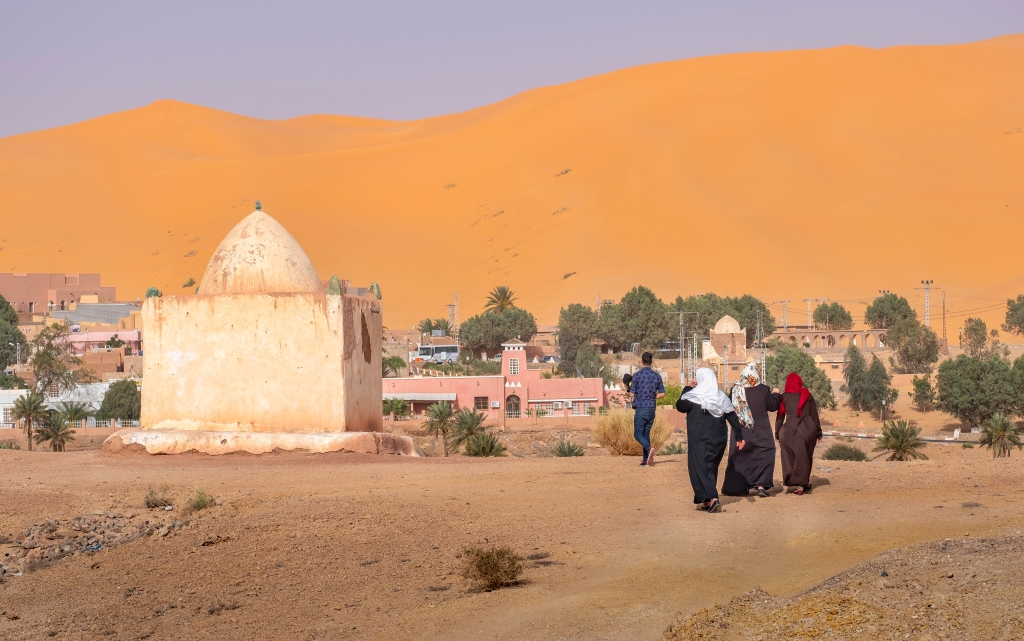Each year, on the twelfth day of Rabiʿ al-Awwal, Algeria transforms. Candles glow in ancient medinas, drums echo in ksour of the desert, and children in velvet and embroidery are paraded into photo studios. Yet beneath the culinary abundance and traditional dress lies a less examined element of Algeria’s Mawlid: the movement of people, both symbolic and physical. In cities and Sahara alike, Mawlid becomes a network of small pilgrimages, linking homes, cemeteries, zawiyas, and mausoleums.
This annual festival is not merely a commemoration of the Prophet Muhammad’s birth – it is a ritual journey, often repeated across generations, that reveals how deeply pilgrimage culture is embedded in Algeria’s spiritual landscape.
From Cemeteries to Zawiyas: Mawlid as a Ritual Path

The Mawlid season often begins with a quiet, local form of pilgrimage. In both rural and urban areas, families head to cemeteries to offer prayers for their departed—an act of remembrance layered with sacred intent. These visits are not peripheral to the celebration; they set the tone for a communal ethic that blends the living and the dead in shared spiritual space.
From there, gatherings move into homes and mosques, with devotional halqas—circles of dhikr, storytelling, and communal chanting. These assemblies often center on zawiyas, local religious lodges linked historically to Sufi brotherhoods. Across Algeria, especially in the highlands and the northern towns, pilgrimage to a zawiya on Mawlid night remains an enduring practice. These lodges act as both ritual sites and educational centers, connecting the faithful through oral history and spiritual lineage.
The Sboûa of Gourara: A Desert Pilgrimage Recognized by UNESCO
The most explicit expression of pilgrimage during Mawlid in Algeria takes place in the Sahara, where the Sboûa—a seven-day religious procession through the ksour (fortified villages) of the Gourara region—offers a rare convergence of mobility, heritage, and devotion.
Centered in Timimoun, the Sboûa mobilizes entire communities who journey to the mausoleum of Sidi El Hadj Belkacem, a 17th-century figure whose zawiya has anchored religious life for centuries. What unfolds is a pilgrimage with choreography: delegations of walkers, musicians, and flag-bearers make a loop through several villages before arriving at the zawiya. The final day sees thousands of participants in converging processions, reciting, dancing, and sharing food. Some walk dozens of kilometers—rehearsing a route known since childhood.
This is not simply spectacle. The Sboûa follows a precise oral protocol, passed down through tribal elders and zawiya leaders. Women contribute through preparation of communal meals and ritual grinding of grains—a quiet but essential element of the journey.
UNESCO’s recognition of the Sboûa in 2015 as intangible heritage underscores its unique character: a seasonal pilgrimage that reaffirms communal ties, geographic memory, and ritual timekeeping across Algeria’s vast and arid south.

Mawlid’s Micro-Pilgrimages: A National Practice of Movement
What the Sboûa makes visible in the Sahara happens, in smaller scale, across Algeria. Mawlid generates a flow of people: from urban centers to rural zawiyas; from city outskirts to ancestral villages; from home to home as family elders are visited and meals shared; and from childhood memory into adult ritual, as new parents take children out in traditional dress to repeat the journeys they once took.
In this way, Mawlid becomes a national pilgrimage of proximity—a vast movement that doesn’t always involve great distances, but which creates spatial circuits of belonging. These annual loops, from cemeteries to kitchens to zawiyas, form what anthropologist Michel de Certeau might describe as “spatial stories”—movements that give meaning to place, memory, and identity.
Temporal Pilgrimage: Shifting Dates, Cyclical Meaning
The lunar Islamic calendar ensures that Mawlid migrates across the seasons—an eleven-day shift each year. This temporal drift adds a cyclical rhythm to these pilgrimage-like movements. The arrival of Mawlid is anticipated through seasonal cues: chicken prices spike, confectioners stock semolina and almonds, and streets fill with noise and scent.
Yet each year’s route—be it to Timimoun, a family grave, or a neighborhood zawiya—is walked again. This ritual repetition across changing seasons imbues the act with permanence.
Pilgrimage Without Departure
In Algeria, Mawlid blurs the boundary between celebration and journey. It embodies the idea of pilgrimage without distance—a set of ritualized circuits that tether Algerians to sacred history, local geography, and collective memory. Whether by foot across Saharan plains or by custom within a family home, Mawlid in Algeria becomes a pilgrimage of presence—one that reveals how cultural heritage and movement intertwine in the living fabric of a nation.




